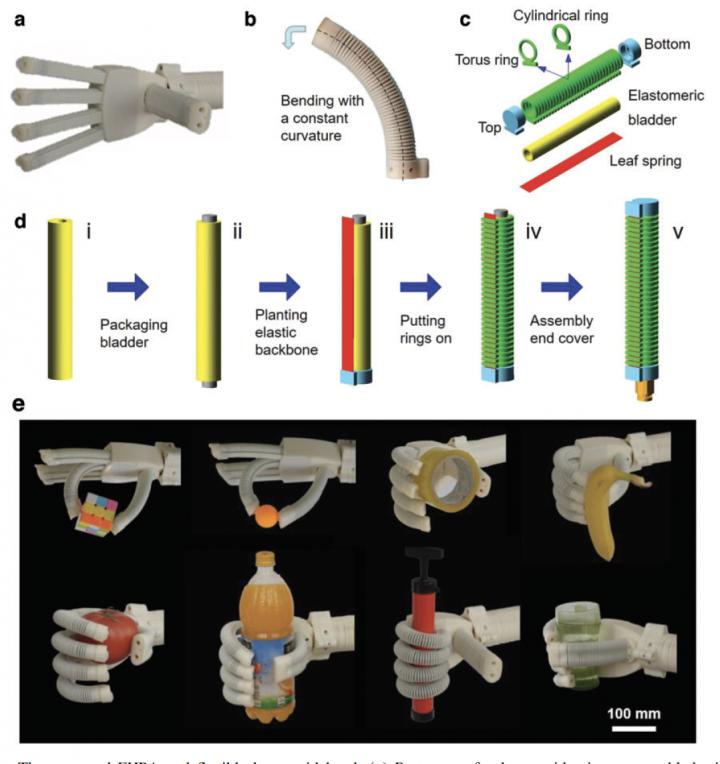Powerful human-like hands create safer human-robotics interactions

The novel humanoid hand design is a soft-hard hybrid flexible gripper that can generate larger grasping force than a traditional pure soft hand. Credit: Changyong Cao
In industrial settings, robots often are used for tasks that require repetitive grasping and manipulation of objects. The end of a robot where a human hand would be found is known as an end effector or gripper.
“The novel humanoid hand design is a soft-hard hybrid flexible gripper. It can generate larger grasping force than a traditional pure soft hand, and simultaneously be more stable for accurate manipulation than other counterparts used for heavier objects,” said lead author Changyong Cao, director of the Laboratory for Soft Machines and Electronics at MSU and assistant professor in Packaging, Mechanical Engineering, and Electrical and Computer Engineering.
This new research, “Soft Humanoid Hands with Large Grasping Force Enabled by Flexible Hybrid Pneumatic Actuators,” is published in Soft Robotics.
Generally, soft-hand grippers — which are used primarily in settings where an object may be fragile, light and irregularly shaped — present several disadvantages: sharp surfaces, poor stability in grasping unbalanced loads and relatively weak grasping force for handling heavy loads.
When designing the new model, Cao and his team took into consideration a number of human-environment interactions, from fruit picking to sensitive medical care. They identified that some processes require a safe but firm interaction with fragile objects; most existing gripping systems are not suitable for these purposes.
The team explained that the design novelty resulted in a prototype demonstrating the merits of a responsive, fast, lightweight gripper capable of handling a multitude of tasks that traditionally required different types of gripping systems.
Each finger of the soft humanoid hand is constructed from a flexible hybrid pneumatic actuator — or FHPA — driven to bend by pressurized air, creating a modular framework for movement in which each digit moves independently of the others.
“Traditional rigid grippers for industrial applications are generally made of simple but re- liable rigid structures that help in generating large forces, high accuracy and repeatability,” Cao said. “The proposed soft humanoid hand has demonstrated excellent adaptability and compatibility in grasping complex-shaped and fragile objects while simultaneously maintaining a high level of stiffness for exerting strong clamping forces to lift heavy loads.”
In essence, the best of both worlds, Cao explained.
The FHPA is composed of both hard and soft components, built around a unique structural combination of actuated air bladders and a bone-like spring core.
“They combine the advantages of the deformability, adaptability and compliance of soft grippers while maintaining the large output force originated from the rigidity of the actuator,” Cao said.
He believes the prototype can be useful in industries such as fruit picking, automated packaging, medical care, rehabilitation and surgical robotics.
With ample room for future research and development, the team hopes to combine its advances with Cao's recent work on so-called 'smart' grippers, integrating printed sensors in the gripping material. And by combining the hybrid gripper with 'soft arms' models, the researchers aim to more accurately mimic precise human actions.
###
The co-authors of the paper include Xiaomin Liu, MSU student Shoue Chen, MSU Foundation Professor Xiaobo Tan from the Department of Electrical and Computer Engineering, and Yunwei Zhao and Dexu Geng from Beihua University.
This research was partially funded by the U.S. Department of Agriculture-National Institute of Food and Agriculture (1016788), MSU Strategic Partnership Grant, National Natural Science Foundation of China (51275004) and an MSU Startup Grant.
(Note for media: Please include a link to the original paper in online coverage: https:/
Michigan State University has been working to advance the common good in uncommon ways for more than 160 years. One of the top research universities in the world, MSU focuses its vast resources on creating solutions to some of the world's most pressing challenges, while providing life-changing opportunities to a diverse and inclusive academic community through more than 200 programs of study in 17 degree-granting colleges.
Follow MSU News on Twitter at twitter.com/MSUnews.
Media Contact
All latest news from the category: Information Technology
Here you can find a summary of innovations in the fields of information and data processing and up-to-date developments on IT equipment and hardware.
This area covers topics such as IT services, IT architectures, IT management and telecommunications.
Newest articles

Pinpointing hydrogen isotopes in titanium hydride nanofilms
Although it is the smallest and lightest atom, hydrogen can have a big impact by infiltrating other materials and affecting their properties, such as superconductivity and metal-insulator-transitions. Now, researchers from…

A new way of entangling light and sound
For a wide variety of emerging quantum technologies, such as secure quantum communications and quantum computing, quantum entanglement is a prerequisite. Scientists at the Max-Planck-Institute for the Science of Light…

Telescope for NASA’s Roman Mission complete, delivered to Goddard
NASA’s Nancy Grace Roman Space Telescope is one giant step closer to unlocking the mysteries of the universe. The mission has now received its final major delivery: the Optical Telescope…



